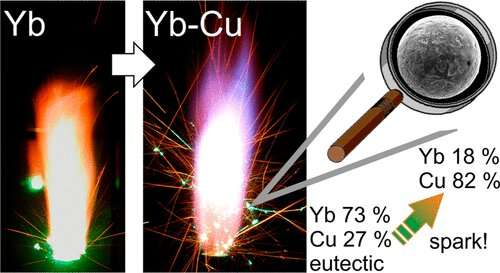Researchers use rare-earth metals in alloy powders to produce green, eye-catching sparklers

Sparklers can be a lot of fun—glimmering, fizzing and spitting out arcs of light from handheld sticks or tubes on the ground. But the metals that they're usually made with limit what the sparks can look like. Now, researchers in ACS Omega report that rare-earth metals in alloy powders can produce flashes that shift from golden to green and continuously branch.
Around the world, sparklers are brought out for holidays and special events, providing celebratory pops of light. While their flames can span the colors of rainbow, the flares shooting out have been limited to dark red, gold or bright white light.
Recently, Eike Hübner and colleagues found that burning powdered erbium (Er), a rare-earth metal, produces a new color-changing spark, shifting from golden-white to bright green. However, the green phase occurred for just a blip in time and wasn't really noticeable.
Another entertaining aspect of sparkler fountains are their branching sparks that burst apart repeatedly into multiple, smaller particles that flash. Commercial sparklers typically contain iron-carbon powders for this effect, but metal-metal alloys can also do this. So, Hübner and the team wanted to test whether rare-earth metal-metal alloys could be used to create brand-new types of color-changing or branching sparks.
The researchers pressed single-metal powders and metal-metal alloy powders, containing alkali, transition and rare-earth metals, one at a time into a flame. Rare-earth alloys provided more colorful sparks than the single-metal powders. For instance, ytterbium produced intense green explosive flashes. But when the ytterbium-copper (Yb-Cu) alloy was burned, it continuously released a shower of long sparks that switched from golden to deep green.
Then the researchers combined rare-earth metal alloys with an ammonium perchlorate and nitrocellulose-based propellant to create smokeless fountains. A powdered version of neodymium magnets created the most attractive fountain with continuously branching sparks, with each initial "parent spark" shooting off many more sparks in just a fraction of a second. These tests yielded two promising sparkler materials, though the researchers caution that the recipes must undergo further safety testing before they can be used in commercial products.
More information: Philipp Memmel et al, Customizing the Appearance of Sparks with Binary Metal Alloys, ACS Omega (2022). DOI: 10.1021/acsomega.2c03081
Journal information: ACS Omega
Provided by American Chemical Society





















